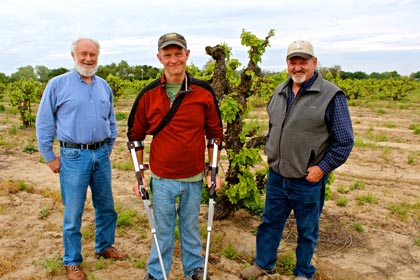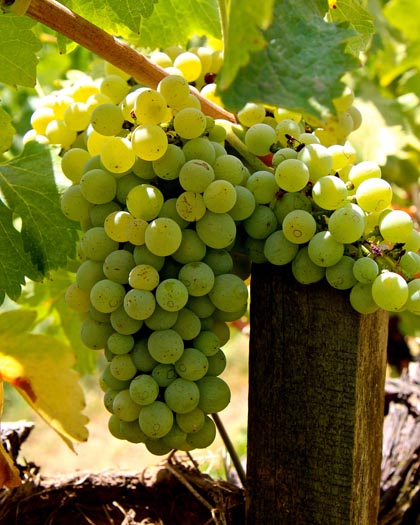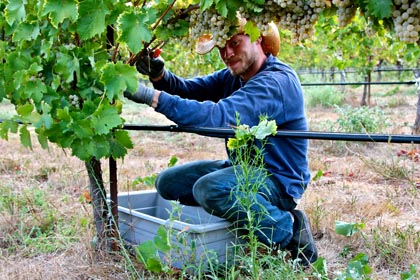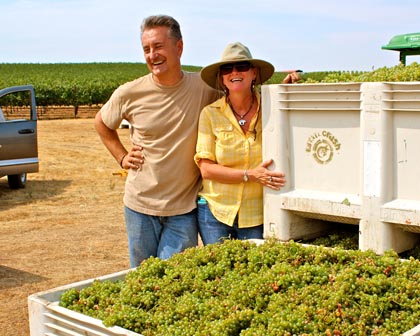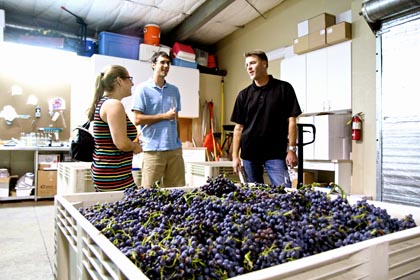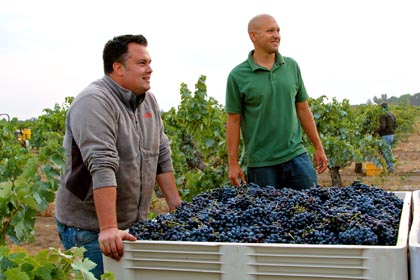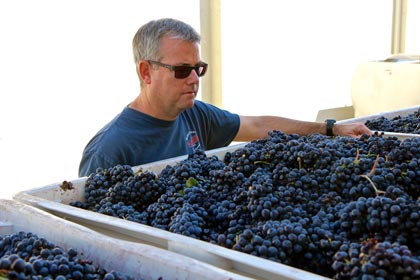Letters from Lodi
An insightful and objective look at viticulture and winemaking from the Lodi
Appellation and the growers and vintners behind these crafts. Told from the
perspective of multi-award winning wine journalist, Randy Caparoso.
What makes today’s Lodi wines special?
Four reasons why Lodi wines are so special: !ZaZin and REDS winemakers Ray Kaufmann and Patrick Campbell (left & center), Klinker Brick owner/grower Steve Felten, and ancient, gnarly 109-year old Rauser Vineyard Carignan vine
What makes Lodi wines special?
Just ten, fifteen years ago, the stock image of Lodi was as a place where
• Gigantic wineries, such as E. & J. Gallo and Woodbridge by Robert Mondavi, get their grapes for their bulk wines.
• There is a lot of Zinfandel.
My, how time flies. Lodi is still known for Zinfandel, and much of the AVA‘s grapes still supply big wineries. But all of the sudden, Lodi is also becoming known for more, much more. We are counting at least seven "new" ways in which Lodi is now being defined in the minds of consumers, media, and the wine trade.
Let us count those ways, while citing some specific examples that anyone can try as proof positive:
Cresci Vineyard Chenin Blanc
1. Lodi is ideal for white wine grapes
Lodi's climate is very Mediterranean, which is why black skinned grapes like Zinfandel (which originated in Adriatic wine regions) do so well here. But it is easy to forget that all around the Mediterranean basin, white wine grapes also thrive, producing white wines that are every bit as fresh, light and zesty in natural acidity as white wines from Northern European countries.
The Lodi grown Uvaggio Vermentino ($14), for instance, is a perfect example; made from a grape grown throughout Southern France and the islands of Corsica and Sardinia. But even wines like LangeTwins Family Sauvignon Blanc ($15; from a grape common to France's Loire and Bordeaux regions) and Six Hands Cresci Vineyard Chenin Blanc ($16; made from a Loire River grape) offer irrefutable proof that white wines as lemony crisp, pure (needing zero acidification) and delicate as white wines from anywhere in the U.S. can be produced in Lodi – if grown sensibly, and picked when the grapes' intrinsic acids are still in balance.
2. Lodi is innovative
In fact, it is in the area of white wines that Lodi has been at the forefront of the American wine industry, in multiple ways. Exhibit A: Borra Vineyards' Artist Series White ($18) is an amazingly sleek, dry, minerally textured white wine made from the Kerner and Bacchus grapes – unusual German white wine crosses, practically unheard of in the rest of the U.S. – without one iota of manipulation in the vineyard or winery.
For going on fifteen vintages, Bokisch Vineyards has been leading the industry with perhaps the purest, freshest varietal bottlings of Albariño, and more recently, Verdelho ($18), Garnacha Blanca ($18), and Verdejo ($18). Acquiesce has been exciting white wine lovers with its "naked" (i.e. no oak), naturally crisp Grenache Blanc ($23) and Picpoul Blanc ($23). Utilizing the exotic Torrontés grape, producers like Kenneth Volk ($24), Forlorn Hope ($22), and Wise Villa ($29) have been opening eyes, while winning "best white wine" sweepstakes awards like nobody's business.
The evidence is mounting: there is now as much winemaking moxie going on in Lodi as in any other region.
Mokelumne Glen Vineyard Kerner harvest, going into Borra’s Artist White
3. Lodi is a natural for Italian
We're saying this because there are numerous other parts of the U.S. where vintners have tried in vain to produce red wines of significance from grapes like Sangiovese, native to Italy's Tuscany region (producing the famous red wines of Chianti, Montalcino, etc.). In recent years, Lodi producers have been making it look easy: the Sorelle Sangiovese ($23) and Fields Family Il Ladro ($25), for instance, have all the zip, balance, and buoyancy of red-berried fruit wine lovers are always seeking in authentic Italian Sangiovese.
There are other examples of Lodi producers excelling in Italian varietals: the properly edgy yet triumphantly long, fleshy St. Amant Leventini Vineyard Barbera ($18); the multifaceted, peppercorn and cardamom spiced Watts Los Robles Vineyard Montepulciano ($25); the bright, densely coiled Klinker Brick Dolcetto ($25); the masculine, four-squared Peltier Station Teroldego ($35); not to mention the downright hunky, powerful, purple raimented Mettler Family Aglianico ($40).
Fifteen years ago, whodathunk? All we know is that, today, Lodi is turning out magnificent bottlings of Italian style reds seemingly with ease; boding for an exciting future in this expanding category.
Markus and Liz Bokisch with Verdelho harvest in Lodi’s Borden Ranch AVA
4. Lodi is a Portuguese pioneer
Over the past +100 years, Portuguese emigrants have had just as much influence on Lodi's culture and agricultural industry as Italians and Germans, and arguably more than the Dutch, Japanese and Chinese. So it comes as no surprise that in recent years Lodi grown Portuguese varietals – especially those by growers of Portuguese descent, such as Silvaspoons Vineyards' Ron Silva – have garnered as much, or more, awards in the big time competitions (San Francisco Chronicle Wine Competition, California State Fair, Los Angeles International Wine Competition, et al.) as any other varietals.
Recent big winners include the Jeff Runquist Souzão ($24), Fenestra Touriga ($22), and Verdelhos by Lee Family ($16), St. Jorge ($18), Twisted Oak ($19), and Quinta Cruz ($20). And although it is not the type of wine seen in wine judgings, Forlorn Hope's Suspiro del Moro Alvarelhão ($26) has been wowing "cool-kid" wine lovers in recent years for its pristine, native yeast fermented, unfiltered/unnothinged expression of this alluringly scented grape.
Fields Family winemaker/partner Ryan Sherman (right) with 2014 Syrah pick
5. Lodi wines can be lavish
By lavish, we don't mean pricey; but rather, extravagant on a sensory level: intense, powerful, multi-faceted aromas and flavors, touching every part of the palate. Cabernet Sauvignon, for instance, is commonly considered a very lavish varietal. In recent years, the Lodi grown Cabernet Sauvignons by the Mettler Family ($25), the Michael David Rapture ($59), as well as the LangeTwins Family Midnight Reserve ($30; Cabernet Sauvignon blended with Malbec and Petit Verdot) have certainly been lavish in every way. Most recently, the Viñedos Aurora Don Victor ($39; reserve level Cabernet Sauvignon blended with Petite Sirah) has also been hitting on all sensory cylinders.
Other Lodi grown varietals fit this description just as well. Michael David's Earthquake Petite Sirah ($26), for instance, was voted "Best Petite Sirah" in the state at the most recent California State Fair, and is as lavishly rich and full as any wine, from any grape. At the same show, Michael David's Inkblot Cabernet Franc ($35) – a vividly dark, layered, sumptuous red wine – was named "Best Lodi Wine," and is amazingly free of any of the green, herbaceous flaws typical of the vast majority of Cabernet Francs produced in France or the U.S.
The Pasos Charbono ($38) is big, yet deep, classically structured, with a sense of being able to age forever. And the Syrahs by Klinker Brick ($20) and Fields Family ($24) are downright extravagant; consistently intense, penetrating, decadently flavorful and perfumed paragons of the grape.
Turley’s Tegan Passalacqua and Michael David’s Emiliano Castanon with Bechthold Vineyard Cinsaut
6. Lodi wines are honest
By this, we mean Lodi wines are not just inexpensive – they way over-deliver on quality for the price. For instance, you have to pay $30 to $40 for Zinfandels grown outside Lodi to get as much flavor and satisfaction as Lodi grown Zinfandels such as Harney Lane ($22), Michael David's 7 Deadly Zins ($16), Jessie's Grove's Earth, Zin & Fire ($14), !ZaZin ($18), Gnarly Head ($14), Heritage Oak ZINHEAD ($25), the Sorelle Primitivo ($22), or any number of Lodi bottlings in these price ranges.
There are many other examples of Lodi wines of unbelievable quality for the price. At the lower end, wines like Peltier Station's zesty Hybrid Sauvignon Blanc ($10) and Ironstone's meaty, almost feral Petite Sirah ($12) jump out at you. The luscious, beautifully focused Bokisch Garnacha ($18) keeps winning "best of class" awards at stiff competitions like San Francisco Chronicle's; and Odisea Wine Company's fleshy, creamy, billowingly aromatic hogshead (300 liter barrel) fermented Cochon Grenache Blanc ($25) is easily on the par with white Rhônes selling for more than twice the price. And considering the rarity of the varietal (at least in California), the amazingly bright, brambly, full flavored Mettler Family Pinotage ($24) is a veritable steal.
Then there are Lodi's heritage bottlings, made from positively ancient vines: the wildly intense Carignans by McCay ($28; from 105-year old vines) or Jessie's Grove ($32; 126-year old vines). The Borra Heritage Red ($25) is a magnificently meaty, pungent, earthy field crush and co-ferment of 50-year old Barbera with 80-year old Carignan, Petite Sirah and Alicante Bouschet. Even more astounding buys are any of the exceedingly refined, silky, magically scented Cinsauts sourced from Lodi's historic Bechthold Vineyard (planted 128 years ago!): bottlings by Onesta ($29), Turley ($18), Michael David ($25), or Estate Crush ($26).
Let's just say it like it is: for what you get – often from phenomenally low-yield vines – Lodi wines can be ridiculously well priced.
Double threat: Adam Mettler; star winemaker for both Michael David and Mettler Family
7. Lodi wines can be elegant
In the world of wines, it is the wines that are exceptionally well balanced, and taste as much of their terroir (i.e. place of origin) as the grape, a winemaker's stamp or brand style, that are considered the most elegant. Elegance is the mark of an ultimate wine because an elegant wine not only tastes great, but it also speaks of other things that are real and tangible – a distinctive character, an organic nature or even soulfulness, compared to wines that are simply hammered and manipulated into tasting like whatever the commercial market, or score obsessed critics, expect.
Most wines from Lodi are not like this; just like most wines from Napa Valley, Santa Barbara, anywhere in Australia, South America or most wine regions of the world are not like that either. But like these other wine regions, there are now a few wines grown in Lodi that could be described as elegant – wines that speak softly, while carrying heap big schtick.
The minimalist, single vineyard, native yeast fermented bottlings in the Lodi Native project ($180/6-bottle cases), for instance, are now highlighting some of Lodi's most venerated Zinfandel vineyards. These are Zinfandels that taste less like most people's varietal expectations, and more like where they are grown; while broadcasting broad, if subtle, sensory delineations between vineyards grown on the west side of Lodi's Mokelumne River AVA (earthier, softer, lusher styles of Zinfandel) and the east side of the Mokelumne River AVA (zestier, firmer, more fruit-concentrated styles).
We are also just beginning to see Zinfandels by several producers from old Lodi growths like Kirschenmann Vineyard (planted in 1915), showing similar understated qualities. From much younger vines, grown in Lodi's Borden Ranch AVA by Markus Bokisch, the natural yeast fermented Neyers Vista Luna Vineyard Zinfandel ($24) is pretty, proportionate, sleek and intriguingly spiced. The quietly intense Cinsaut reds from the previously cited Bechthold Vineyard are also carving out their own terroir driven niche.
It's happening as we speak: Lodi wines showing distinct sense of place. Not a lot of them, as of yet, but enough to know that even here in the underestimated Delta, wines of classic, understated elegance are very possible.
Lodi is becoming even more… special!
Lodi Native winemaker and grapes: St. Amant’s Stuart Spencer with Marian’s Vineyard Zinfandel
